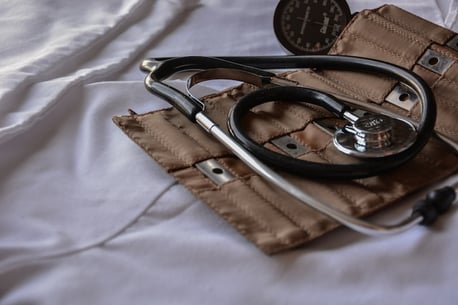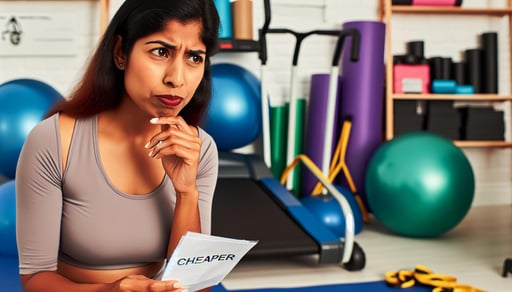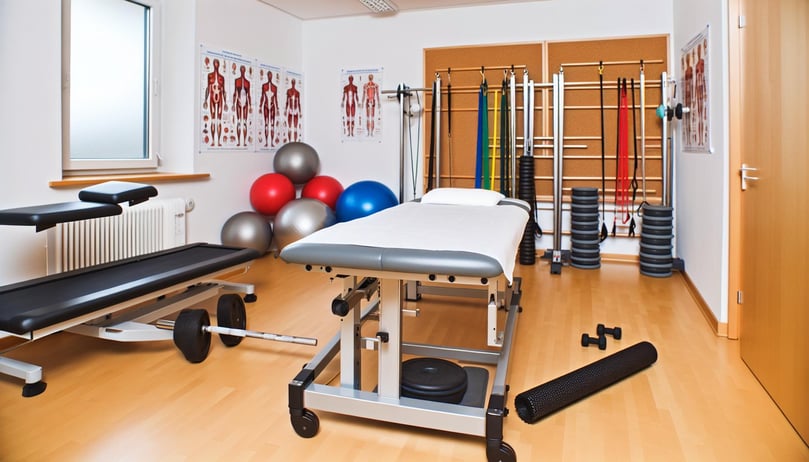October 23, 2023
A Budget Guide to Physical Therapy Equipment for PTs
A Budget Guide to Physical Therapy Equipment for PTs
Running a private physical therapy office is expensive. Initial costs include permits, insurance, and software. And, of course, the equipment. It can get a bit pricey, with parallel bars averaging around $800 to $1,300, and that's not even including other equipment needed around the clinic.
Saving every penny is vital to having a profitable private PT clinic. So, how can PTs provide top-notch equipment to patients without breaking the bank?
This guide explains how to budget for physical therapy tools effectively.
You'll learn:
- The physical therapy equipment checklist
- Six ways to spend less on PT equipment for your practice
- The importance of maintaining PT equipment supplies
Physical Therapy Equipment Checklist

No doubt you have some idea of what kind of physical therapy supplies you need for your clinic. But if it's been a while since you've updated your equipment, consider refreshing your practice with new assets for improved patient rehabilitation.
Practice Management Software
An efficient practice management solution will optimize all aspects of your practice, including equipment effectiveness.
Your software's features can reveal a lot about the quality of the equipment in your programs.
Tracking patient activity: If your clients struggle to complete assignments from the dashboard, review equipment compatibility with patient needs to ensure program completion.
Connecting with patients: Ask patients directly about the effectiveness of your products. Patients can conveniently respond from their phones if your software includes an app.
Reporting: Are there current trends in patient outcomes, clinic goals, and equipment effectiveness analytics that inform your equipment investment decisions? Consistently monitoring these analytics can help you make critical equipment investment decisions.
Let me know if your patient management software can give you these insights. If not, consider finding an all-in-one practice solution to handle all this and more.
Office Supplies
That's right - equipment doesn't just apply to the ones patients use on the exercise floor. It's crucial to consider equipment for every area of your clinic, from the administrative side to the waiting room. Your staff and patients deserve the best resources to ensure efficient operations and a welcoming environment.
Here are essential physical therapy supplies to secure for your PT office:
Desk and Chairs: A comfortable desk and chairs are necessary for your administrative staff to complete their tasks. They provide a dedicated workspace for scheduling appointments and managing patient walk-ins. Additionally, comfortable seating is important for patients during consultations or while waiting for their appointments.
Furniture: Other furniture, such as cabinets, shelves, and storage units, helps keep the clinic organized and clutter-free. These provide space for storing medical supplies, exercise equipment, and therapeutic aids.
Cleaning Supplies: A clean and hygienic PT clinic is crucial. Use disinfectants, wipes, gloves, and sanitizers to prevent germ spread and ensure the safety of patients and staff. Regular cleaning routines enhance professionalism and appearance.
Computers: Computers are integral to modern healthcare practices, including PT clinics. They allow for EMR (Electronic Medical Records) management, appointment scheduling, billing, and communication with patients and insurance providers. Ideally, all of these should be easily accessible by management.
Test and Measurement Devices
Objective data is crucial to assess, diagnose, and monitor patient progress, ensuring accurate rehabilitation programs based on individual needs.
Evaluate these clinic items to ensure they're up to date:
Goniometers: Assist in measuring joint angles, assessing range of motion (ROM), identifying limitations, and tracking therapy progress. They assist in developing treatment plans for joint ROM.
Grip Dynamometer: Measure handgrip strength, an essential indicator of upper body strength. These devices evaluate rehabilitation progress, assess muscle weakness, and guide treatment planning for hand injuries, arthritis, or neurological disorders.
Stethoscope: Aid in assessing cardiovascular and respiratory function, identifying abnormalities, and monitoring vital signs during exercise or rehabilitation sessions. Stethoscopes provide valuable information for determining exercise intensity and tolerance levels.
Reflex Hammer: Reflex hammers elicit and assess deep tendon reflexes. Physical therapists use them to evaluate nerve function, detect abnormalities in reflex responses, and diagnose conditions affecting the neuromuscular system. Reflex hammers assist in formulating treatment plans and monitoring neurological progress.
Basic P.T. Equipment
In this case, being basic is okay! These tools are widely used in the PT industry. You probably have some (if not all) of them, but it's always good to do a self-check to see how they're holding up and if it's time to replace them with newer editions.
How are these items in your clinic looking?
Mat Table: Is this still supporting your patients during treatments and allows you to work comfortably at an appropriate height?
Treatment Tables: Do you have suitable types and sizes, including adjustable height tables and plinths?
Large Mirrors: Are your large mirrors installed on walls correctly to allow patients to observe their movements and posture during therapy sessions?
Linens: Clean linens, including sheets and towels, are essential for maintaining hygiene and providing patient comfort. Is proper laundering and replacement of linens happening frequently enough to maintain infection control standards?
Fitness / Exercise Equipment
This piece of physical therapy equipment is what patients will use daily in your clinic and exercise programs. Ideally, this equipment should be readily available for these patients to get from their HEP.
With that in mind, here are some that should be easy for your patients to obtain:
Exercise Balls: Stability balls offer versatile tools for balance, core strengthening, and postural exercises.Mats: An essential piece of equipment in PT clinics but also can aid in other physical activities such as yoga, Pilates, and stretching routines.
Resistance Bands: Variable resistance can be adjusted to individual needs and is suitable for patients at different strength levels. Resistance bands are lightweight, portable, and versatile, allowing patients to practice exercises anywhere.
Foam Rollers: By applying pressure to specific areas, foam rollers help alleviate muscle tension and improve flexibility. They can be used during warm-up routines, cool-down sessions, or targeted massage and stretching exercises.
In-House Educational Materials
Could you look around your waiting room, exercise area, restrooms, and treatment rooms? What kind of material do you provide for your patients? Having the occasional tabloid in the reception area is fine, but your credibility is more significant in what you place around the room regarding focused care.
Consider adding these to your PT literary collection:
Anatomical Models and Posters: These tools enable physical therapists to explain complex anatomical concepts, identify affected areas, and demonstrate treatment techniques. They enhance patient engagement, facilitate discussions, and promote a better understanding of the rehabilitation process.
Health Education Posters: They educate patients about proper body mechanics, injury prevention strategies, self-care techniques, and exercise guidelines. Health education posters can empower patients to participate in their recovery actively, make informed decisions, and adopt healthy lifestyle habits.
Tablets or Magazines for Patient Education: Provides multimedia presentations, videos, articles, and interactive exercises to enhance patient learning. Tablets or magazines enable patients to access educational materials at their own pace, allowing for independent exploration and reinforcement of critical concepts.
Patient Handouts and Brochures: These materials serve as references for patients to review at home, ensuring they have clear instructions and guidelines to follow. Patient handouts and brochures reinforce therapy concepts, encourage compliance, and support continuity of care beyond clinic visits.
First-Aid & Medical Supplies
Having readily available first-aid and medical supplies is essential in various settings, even if they are never needed.
Make sure you always have a stocked inventory of these medical items:
Basic First Aid Supplies:
- Adhesive bandages (various sizes)
- Sterile gauze pads and rolls
- Medical tape
- Disposable gloves
- Antiseptic wipes or solution for cleaning wounds
- Tweezers and scissors
- Instant cold packs
- Elastic bandages
- CPR mask or face shield
- Splints or immobilization devices
Personal Protective Equipment (PPE):
- Disposable gloves (latex or nitrile)
- Face masks or respirators
- Eye protection (safety glasses or goggles)
Documentation and Reference Materials:
- First aid manuals or guides
- Emergency contact numbers
- Incident report forms
6 Ways to Spend Less on PT Equipment for Your Practice

Are you feeling overwhelmed by the last section? No worries, we totally understand. It was a lot to take in, but if you've got a good idea of what equipment you need to invest in, we've got the strategies to help you get the PT supplies you need within your budget.
Invest In PT Practice Management Software
Practice management software is crucial for budget management in physical therapy (PT) clinics. It helps streamline administrative tasks, optimize billing processes, and boost efficiency.
How does this help with physical therapy equipment? All these features in one platform save you both time and money. And guess what? You can use that extra cash for other awesome things (wink wink, new equipment!).
Not to toot our own horn, but PtEverywhere has been widely used and approved by PT professionals. These testimonials highlight the positive impact of PtEverywhere on daily operations, patient management, and budget optimization. You can find more client testimonials and feedback by visiting this link.
Online Shopping for Quality Deals
E-commerce has been a game-changer for finding the best prices without leaving your house. All you have to do is fire up your laptop.
With many brands vying for your business and promoting their physical therapy equipment as the best, consider these criteria when browsing sites:
User Reviews: Online platforms often feature user reviews and ratings for products. These reviews offer insights into the quality, durability, and value of the equipment you're considering. Remember to read reviews from other PTs! It's essential to ensure your colleagues are satisfied with the product.
Specialized Website and Trusted Platform: Specialized websites dedicated to specific industries or equipment types can provide cost-effective options. Websites like medicalsupplydepot or quickmedical focus on medical supplies and equipment, often offering competitive pricing on physical therapy tools. Platforms such as Amazon or eBay offer various affordable and discounted options.
Creativity in Equipment Procurement
Just because you are budgeting doesn't mean you can't be creative. Thinking outside the box can save you more money in the long run.
Explore Alternative Options: Explore non-traditional channels and consider alternative sources for equipment procurement. Seek lightly used or refurbished equipment for substantial cost savings without sacrificing quality.
Networking and Partnerships: Engage with other physical therapists or healthcare professionals to share information and resources. Collaborating and forming partnerships within the industry may open up opportunities for equipment sharing, exchange, or joint purchasing, further reducing costs.
Efficiency and Simplicity in Practice
Simplifying and streamlining the day-to-day operations of your PT clinic can not only declutter your office but also save you money by avoiding the need for complex supplies and equipment.
Cost-effective Equipment Solutions: Instead of purchasing a complete machine system like ultrasound therapy, consider buying separate portable machine units. This approach can be more budget-friendly while providing the necessary functionality for any equipment in your practice.
PtEverywhere for Practice Management: Simplify admin and patient communication with PtEverywhere practice management software. Features like progress monitoring, scheduling, and a mobile app to streamline personalized exercise programs are user-friendly and require no learning curve.
Leasing or Renting Physical Therapy Equipment
Let's be honest: committing can be challenging. If you're hesitant about buying expensive physical therapy machines, leasing or renting is always a solid option.
Maintenance and Support: Maintenance and support services are included in many leasing or rental agreements. This means you can rely on the physical therapy equipment provider for repairs, servicing, and technical support, saving you time and effort.
Trial Periods: Some equipment lease or rental agreements may offer trial periods, allowing you to assess the equipment's suitability and functionality in your practice before committing to a long-term purchase.
Tailoring Equipment Purchases to Your Practice Model
Your clinic and PT brand are unique; your purchase equipment should reflect that. Get equipment that represents the professionalism of your practice.
Here's why it matters and how budget tracking can help:
effectively addresses
Your clinic's specific services and treatments: By considering your clinic's services and ensuring you have the right tools, you can identify the necessary equipment to deliver high-quality care. Matching equipment purchases to your clinic's services effectively addresses patient needs.
(Tip: Budget tracking with PtEverywhere can support matching equipment purchases to your clinic's services by efficiently tracking and managing expenses.)

Financing Options for Physical Therapy Equipment
While upfront costs can be a hurdle, several financing options can help PT practices acquire the equipment they need. Here's a breakdown of some popular options:
1. Small Business Loans
These loans provide a lump sum of capital that can be used for various business expenses, including equipment purchases. They can be a good option for PT practices looking to finance a larger equipment purchase, such as a new ultrasound machine or a specialized treatment table.
-
Term Loans: Term loans are repaid over a fixed period with fixed monthly payments. This predictability can be helpful for budgeting and cash flow management. They are ideal for financing larger equipment purchases with a clear repayment plan in mind.
-
Line of Credit: A line of credit provides access to a revolving line of credit for ongoing equipment needs or unexpected repairs. This flexibility can be advantageous for practices that may need to purchase additional equipment over time or address unforeseen equipment repairs.
2. Equipment Financing
This specialized financing option focuses on financing medical equipment purchases. Equipment financing companies understand the unique needs of PT practices and may offer more competitive rates and terms compared to traditional lenders.
-
Leasing: Leasing allows your practice to use the equipment for a set period with a fixed monthly payment. Ownership may or may not transfer at the end of the lease term. This can be a good option for practices that don't necessarily need to own the equipment long-term or prefer to keep their cash flow available for other needs. However, be aware that leasing typically costs more than purchasing outright in the long run.
-
Loan with Equipment as Collateral: This option allows you to secure a loan with the equipment itself serving as collateral. This can offer lower interest rates than traditional small business loans due to the reduced risk for the lender. It's a good option for practices with good credit history looking for a more affordable financing option but be prepared to potentially forfeit the equipment if you default on the loan.
3. Merchant Financing
Some medical equipment suppliers offer their own financing options directly to PT practices. These options can be convenient and may offer competitive rates and terms tailored specifically to the equipment you are purchasing.
-
Vendor Financing: Vendor financing allows you to finance the equipment directly through the supplier, often with flexible terms and competitive rates. This can simplify the financing process and potentially lead to faster approval times. However, it's important to compare rates and terms from other lenders before committing to vendor financing.
-
Point-of-Sale (POS) Financing: POS financing options are offered at the time of purchase, often with shorter terms and approval processes. This can be a good option for smaller equipment purchases where you need financing quickly and easily. However, these financing options typically have higher interest rates than other options.
Choosing the Right Financing Option:
Consider these factors when selecting a financing option:
-
Loan Amount: How much financing do you need?
-
Interest Rates: Compare rates and terms from different lenders.
-
Repayment Terms: Choose a repayment schedule that fits your cash flow.
-
Early Payment Options: See if there are any penalties for prepaying the loan.
Why Is Maintaining PT Equipment Supplies Important?
Whether it's software, exercise equipment, or office furniture, all these are important to maintain at your clinic. It helps ensure the safety of your patients, enables your staff to work efficiently, and gives your practice a professional and welcoming vibe.
Of course, nobody's budget is limitless, so check out the budget-friendly tips from the guide to get all the equipment you need at an affordable price.
PtEverywhere provides insights on equipment effectiveness through our PT management software. Easily track patient outcomes and receive crucial equipment feedback, all on one platform.
Happy savings!


